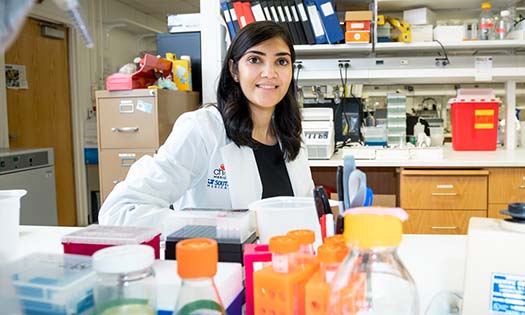The insight: Practical recommendations for treating adolescents with GLP-1RAs
The rate of obesity in children and teens in the U.S. has skyrocketed in recent decades, and with it, the rate of metabolic dysfunction-associated steatotic liver disease (MASLD), previously known as non-alcoholic fatty liver disease (NAFLD). About 40% of pediatric patients with obesity have MASLD, which can eventually lead to life-limiting conditions like liver failure, liver cancer or cirrhosis.
Using glucagon-like peptide-1 receptor agonists (GLP-1RAs), like liraglutide and semaglutide, has enabled the Pediatric Liver Disease Center at Children’s Medical Center Dallas, part of Children’s HealthSM, to improve care for adolescent patients with MASLD well beyond what was possible with diet, exercise and traditional anti-obesity medications. Although the U.S. Food and Drug Administration (FDA) approved these medications for children 12 and older with obesity in 2020, many pediatricians and pediatric gastroenterologists are still hesitant to use them.
Sara Hassan, M.D., Pediatric Gastroenterologist and Transplant Hepatologist at Children's Health and Assistant Professor at UT Southwestern says, “GLP-1RAs are fairly new, and concerns about cost, dosing and how to manage them have made it challenging to bring them to the pediatric population. Given these barriers, it is essential to be thoughtful and selective in identifying which patients are most likely to benefit from these therapies.” Dr. Hassan was part of the national physician team that developed a clinical algorithm tailored to treat pediatric patients with MASLD. This tool considers key factors such as severity of obesity, presence of obesity-related comorbidities (e.g., MASLD, hypertension, insulin resistance), psychosocial readiness, and likelihood of adherence to a comprehensive lifestyle-based treatment plan.
What to know: Guidance for diagnosing and managing MASLD
Given the high and rising prevalence of obesity and MASLD in children and adolescents, establishing a structured clinical approach is important for what Dr. Hassan sees as the most critical aspects of caring for pediatric patients with MASLD: diagnosing the condition and aggressively managing it.
The clinical algorithm leads pediatric gastroenterologists and other specialists through the steps of evaluating a child or teen for suspected MASLD. This includes:
Imaging to confirm the presence of steatosis or fat on the liver
Evaluation to screen for severity of liver disease
Testing to rule out viral hepatitis, Wilson’s disease and other conditions that can cause hepatic steatosis and mimic or even coexist with MASLD
Screening for other weight-related conditions, including diabetes and high blood pressure.
“The evaluation is lengthy because it’s important to look at the whole patient,” Dr. Hassan says.
Dr. Hassan also highlights key considerations for prescribing GLP-1RAs, from patient selection to monitoring effectiveness. Key recommendations include:
Considering GLP-1RAs for patients 12 and older who have obesity, MASLD and at least one additional comorbidity such as prediabetes, diabetes, hypertension or obstructive sleep apnea.
Discussing challenges with patients and families like high out-of-pocket costs, insurance options and the potential for regaining weight after discontinuing treatment.
Explaining the importance of healthy diet and exercise before patients begin the treatment to avoid muscle loss and regaining weight after stopping.
Checking for effectiveness of the medications within 3 months after the maintenance dose begins and assessing for common side effects including nausea, vomiting and less common concerns, such as organ damage.
While the FDA approved GLP-1RAs for all children 12 and older with obesity, access to these medications remains a barrier, underscoring the need to be thoughtful and selective in identifying which patients are most likely to benefit from these therapies.
“Our goal is to ensure that these powerful medications are used in a way that maximizes benefit and minimizes harm. By being selective, we aim to allocate resources responsibly and advocate for the patients most in need,” says Dr. Hassan.
“GLP-1RAs are costly and in short supply,” Dr. Hassan notes, adding that most patients with MASLD also have multiple comorbidities, such as prediabetes, insulin resistance and hypertension.
Why it matters: Making haste to identify MASLD
The American Academy of Pediatrics (AAP) currently recommends screening children ages 9 to 11 if they are overweight, obese or have a family history of the disease.
“We are seeing MASLD earlier and earlier in children,” Dr. Hassan says. “This disease is usually silent until it’s not. If it develops into cirrhosis, it can set a child on the path to a liver transplant as an adult. Diagnosing MASLD early provides a critical opportunity for intervention before irreversible liver damage occurs”
Sometimes screening for MASLD reveals elevated levels of the liver enzyme alanine aminotransferase (ALT). Identifying these patients also helps stratify risk, prompting more frequent monitoring or referrals to pediatric hepatology if their levels do not come down after 6 months of diet and exercise.
Multidisciplinary care at Children’s Health for complex liver disease
The Pediatric Liver Disease Center at Children’s Health specializes in caring for adolescents with MASLD who need GLP-1RAs medications. The multidisciplinary team includes a hepatologist and registered dietitian. Additional services within this center include psychology care and social work to help guide long-term lifestyle changes with these medications.
“Many of the patients referred to us are frustrated because they are unable to lose weight to manage MASLD with diet and exercise alone,” Dr. Hassan says. “We think the future is bright with GLP-1RAs. We just need to make them available for everybody in an equitable fashion.”
Learn more about the latest research in gastroenterology at Children’s Health.


